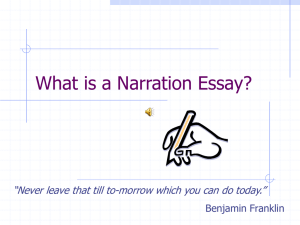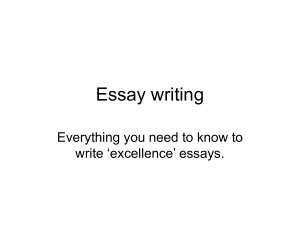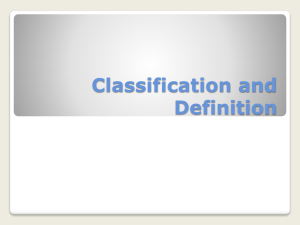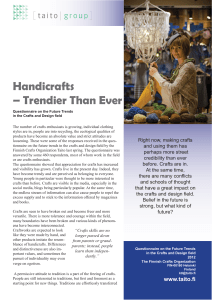The 12 Writing Crafts and their Descriptions
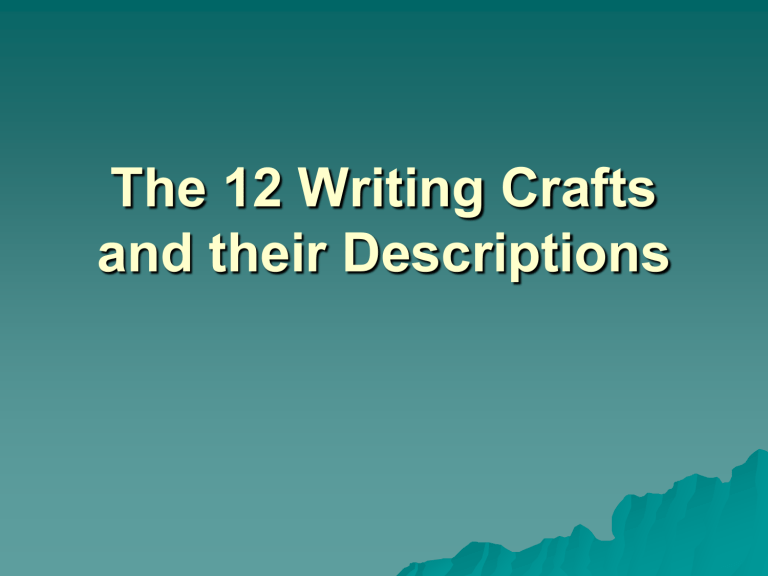
The 12 Writing Crafts and their Descriptions
Creative writing is at the top of the educational pyramid.
All of our readings, observations, visits to interesting places, discussions and experiments have to take shape of some sort of creative writing.
It ’ s what defines you.
It ’ s your signature, your identity and you are remembered for what you write.
There are 12 basic crafts of creative writing that we all need to know how to write.
These 12 crafts make up the language competency that every student must acquire by the time he or she completes the primary education.
It must be prudent to say that primary education is all about language competency, which, in turn, is the ability to write all 12 crafts while following the five steps of creative writing
(Brainstorming, drafting, sequencing, proofreading, and publishing).
Following is a brief description of the twelve crafts. We hope that these descriptions will help teachers in the classroom while they teach children how to do creative writing.
1. Essay
Essay is your point of view mixed with some simple information around a topic.
The topic of an essay can be an object, place, issue or a concept.
Unlike research report which is more technical in nature, an Essay is a light reading.
An essay should have one or more sentences for its opening.
The opening statement should motivate the readers towards reading the essay to the end.
The body of the essay should contain interesting information around the topic.
Rather than giving your information directly, use examples and everyday experiences to do the same.
The closing few lines should make your essay memorable for a reader.
That means well thought out statements that should add some extra flavor to your essay.
2. Story
A story consists of:
– Plot
– Characters
– Setting
The story starts with something interesting that can grab a reader ’ s attention.
The plot should have one or more than one climax, depending on the length of a story.
The story should end with an anticlimax, a point where a conflict is finally resolved.
The characters of the story should be interesting.
The characters should be suitable to the plot of your story;
therefore you should think of your characters, their aptitudes and their behaviors before you start writing the draft.
The setting of the story should be conveyed to the readers directly or indirectly so they can imagine the time and place where the story is taking place.
A good story is a right balance between narrative (told by the story teller) and dialogues between the characters of the story.
Lengthy dialogue confuses the reader, whereas long narrative is simply boring.
Diary
A diary is written to list down all the interesting things that may have happened during the day.
A diary has only the important events of that day.
These events may be happy, sad or just strange.
You write as if you are talking to your diary as well-wisher or a friend, feeling assured that your secrets will be well kept within those pages.
Your daily diary may end with a resolution, a commitment or a plan for the future.
You may write the diary of an unusual object (a traffic light, an oven or a board marker) or you can write the diary of a living thing (a tree, a guard dog or a honey bee).
In each case you need to think of a number of interesting events that may take place in a day of an object or a living thing.
4. Letter
A letter has three major parts.
On the top left side you write the name, title (if any) and the address of the person you are writing it to.
Then comes the body of the letter and finally you give your name.
The first and the last parts of a letter are simple; it ’ s the middle part – the body – that you need to be creative with.
The body of the letter is usually made of three parts or paragraphs.
The opening paragraph defines the purpose for which the letter is written.
In friendly letters, the opening paragraph shows warmth, whereas in a business letter this paragraph states the purpose for which the letter is written.
The second paragraph provides the details of the point raised in the opening paragraph.
It may include some numbers, dates or other evidences to support your point of view.
It is important not to drift too far away from the topic of a business letter (more so than friendly ones).
5. Poem
A poem is a unique way of expressing your feeling of joy or sorrow.
The structure of language used should be different from our everyday expression, as it has lots of images, similes, metaphor and yes some poems rhyme as well.
You may think of a pair of rhyming words and then try thinking of a pair of sentences that may end with these words and you will have a poem that will rhyme!
6. Autobiography
Autobiography is the life of a person or an object from beginning till the end or the most recent times.
You start by conducting research about your subject.
Find out everything about him or her first.
Then brainstorm and start writing in chronological order.
Mention only the important events of the character ’ s life and skip the minor details.
You may write about the exciting moments of the person ’ s life as well as his or her accomplishments.
An autobiography is made more interesting by adding feelings to it.
Sorrows, grieves, happiness, and laughers make an autobiography a pleasure reading.
You can try writing autobiographies of objects, animals, plants and other object found in the nature.
The key is to see and feel things from you characters vantage point.
7. Narration
It provides details of a particular scene or events to a reader just the way it was.
A good narration has all the details, big or small, but it doesn ’ t include any opinion or feeling of the one who is writing it.
The purpose is to provide as much detail to the readers as possible so they can imagine the scene or the event themselves, without being influenced by the writer ’ s opinion.
It is also important to use measurements instead of words when narrating quantities.
For example instead of ‘ very tall ’ say
35 meters tall, and instead of
‘ extremely heavy ’ say 300 tons.
We may start with a brief description of the event or the place or the objects we are about to narrate.
Then we can start describing each segment of the scene or the event one by one.
Narration of an event will move in a chronological order, with the details of every new person or object as it appears.
Whereas, the narration of a place will be done with description of objects more common to uncommon.
8. Interview
Anyone can conduct an interview but not everyone knows how to ask the right questions!
In order to conduct an interesting as well as informative interview, you first need to find out everything there is to be found about the person you are about to interview.
Then start thinking of questions that may be revealing and intriguing.
It ’ s important to find out the favorite color and the place of birth of the interviewee but that ’ s only the beginning.
What ’ s more important are the facts and feelings hidden from others.
Here are some types of questions you may ask:
– Personal information including family education
– Achievements
– Ambitions
– Memorable moments in life
You may also try to answer questions by putting yourself in the place of the interviewee.
That would need careful study of the personality of the interviewee.
Try to look at things from this particular person ’ s point of view when answering these questions.
9. Dialogue/Drama
Dialogue is an everyday conversation taking place between two or more than two people.
That ’ s why the dialogue is written in an informal or spoken language style.
It is important to converse a dialogue before writing it.
Without talking it out first, a written dialogue doesn ’ t sounds like a conversation, rather it starts sounding more like an essay.
A dialogue doesn ’ t necessarily have to be between two human beings only.
It may be done around animals, plants, things found in a home or heavenly bodies.
The topic of the dialogue may vary according to the characters involved in it.
A dialogue may start with greetings and introduction (if the characters are not known to each other previously).
After these opening sentences the dialogue should turn towards a topic of common interest.
The characters may agree on a particular theme or debate around it if they don ’ t agree.
The dialogue ends with good byes and a promise to meet again.
10. News Story
A good news story is based on 6 W:
– What
– Where
– When
– Who
– How
The writer explains the event in a concise manner keeping in mind the 6 w.
The news story also includes some quotations of the people involved in the event.
The writer ’ s job is to make the news seem important and explain the more intriguing or interesting parts of the event to the readers.
It is important to report the unusual part of the incident rather than saying the usual things about it.
As the saying goes: It is not a news when a dog bites a man, but it surely is a news when a man bites a good!
Write the heading for your news story at the end.
Highlight the most important events of the news in your heading.
Research Report
Research report is written to discuss a particular theory, idea invention or the problem.
A research report consists of three parts:
– Opening statement
– Body of the report
– Conclusion
State the problem or the idea precisely, in the first part.
If you are about to address a problem then it should be put forth clearly.
In few sentences explain the whole issue, invention or development.
Then, in the second part, use data, surveys, and other information from your research to support the point you have highlighted in the opening paragraph.
The information you provide in this part should be verifiable, and specific.
You may use charts, graphs and other tools to present the data you have gathered for this purpose.
If the information you are placing in this section is not part of your original research then those sources should be properly cited.
Finally, in the conclusion part, you sum up the discussion by making recommendations or suggesting the utility and it should be practical and relevant.
12. Advertisement
An advertisement has four parts:
Heading
– Body
– Closing
– Art or picture
– Contact information
Heading is written to get attention of the reader.
It shouldn ’ t be too long or too difficult to read.
Also, it ’ s not necessary to cover all the features of a product or a service in the heading.
It is also important to write the heading with the targeted audience in mind.
For example a heading written for school children will be different from the one written for old people.
The body is written to give more details of the product or the service you are offering.
Once again, it has to simple and to the point. Sometimes it is not possible to explain everything, so you should write with most important first!
The language of the advertisement has to be interesting and active.
It has to be motivating and convincing.
You should highlight the features of the product by making good use of adjectives.
Keep your sentences simple and to the point.
By the end of the body of the advertisement, you should be self-assured that you have convinced the readers about the product you have to offer and now you just need to request them to avail the service or buy the product.
Therefore, at the end, you ask them to appropriate action.
The closing consists of one or two sentences and it contains words like: buy, order, visit us, call etc.
A picture is worth a thousand words.
Therefore we should be very careful when choosing it.
A visual (that ’ s what the picture appearing in an ad is known as in the world of advertising) should be selected as carefully.
As a matter of fact, at least 30% of the space in your ad should be taken by the visual.
Finally there should be some contact information in your advertisement.
If you would like people to come to your place of business then give the location, but if it ’ s something that one can order on phone then a phone number with be sufficient.
And what an ad without a website address, so don ’ t forget to add it!
Students in primary classes should go through the five steps of creative writing under a teacher ’ s supervision (collectively or in small groups) when practicing the writing of each craft.
Meanwhile, the students of middle and secondary classes should practice writing a craft while doing all the five steps of creative writing independently without much help from others.
You may contact the EAST, if you are interested in getting any further information regarding the writing of these crafts.
Thank You

